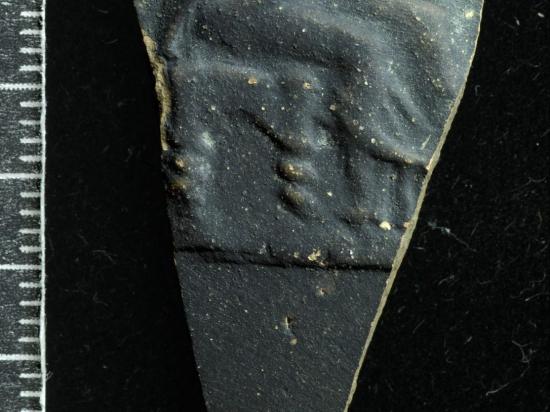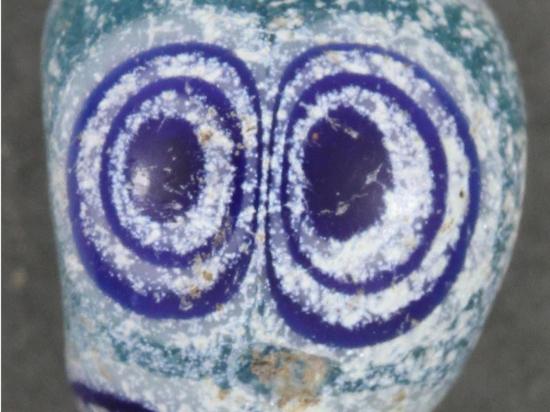Philippe Bohstrom
Source - https://www.haaretz.com/archaeology/.premium.MAGAZINE-pottery-with-parthenon-scene-found-in-biblical-village-1.5731050
A pottery vase found in northern Israel turns out to show the birth of the goddess Athena, an image apparently copied from the frieze of the Parthenon in Athens. Made in Italy 2,300 years ago and found with other luxuries, the imported ceramic sheds new light on the wealth of the inhabitants of e-Tell – the site of biblical Geshur, and, later, possibly, the town of Bethsaida.
The location of biblical Bethsaida remains controversial, but scriptural references place the hometown of the apostles Philip, Andrew and Peter on the northern shores of the Sea of Galilee. E-Tell is located 1.5 kilometers north of the Sea of Galilee. (Other contenders for Bethsaida are el-Araj and el-Mesydiah).
The extraordinary vase had been found among the ruins of the Galilean village a few years ago. It was decorated in unmistakable Apulian style, characteristic of southern Italy. But it is only now, using sophisticated imaging tools and complex software, that Dr. Stefany Peluso with the help of the expeditions photographer, Hanan Shafir, could identify the scene shown on the vase, which has been dated to the 4th century B.C.E.
The shard shows the nymph Dione and goddess Aphrodite looking on as the goddess Athena is born, springing full-grown – and fully equipped with spear and shield - from the head of her father Zeus.
In Homer's Iliad, Aphrodite was the offspring of Dione, a godly creature of eastern origins that Zeus ravished. According the legends, Athenas advent would augur ill for the on-looking mother and daughter: During the Trojan war, Athena would take sides against Aphrodite, who protected Paris, prince of Troy.
The richly decorated potsherd is one of very few surviving copies of the eastern pediment of the Parthenon, the grand marble temple that was erected after the Persian wars, in honor of Athens' protective deity. The statue of the virgin goddess herself, Athena Parthenos, was made of gold and ivory and rose 10 meters high.
 Decorated pottery shard dating to Hellenistic times, the same era the shard with Aphrodite and Dione dates to; found in e-Tell, believed to be the site of ancient Bethsaida - Hanan Shafir
Decorated pottery shard dating to Hellenistic times, the same era the shard with Aphrodite and Dione dates to; found in e-Tell, believed to be the site of ancient Bethsaida - Hanan Shafir
'Ferociously ideological'
In fact, one of the Parthenon decorations depicts the Greek triumph over the Trojans, emphasizing the long-standing enmity between the two peoples.
Few buildings in the history of architecture have been as ferociously ideological in design and decoration as the Parthenon," Prof. Daniel Mendelsohn of Bard College told Haaretz. "Everything about it—from its idiosyncratic incorporation of elements of all three architectural orders (Doric, Ionic, Corinthian)—to the elaborate sculptures and bas-reliefs that adorned its pediments and entablature, bespeaks a desire on the part of the builders to underscore Athenian political, military, and ideological supremacy."
Sculptures on both sides showcase the greatness of Athena, the city's divine protector: her birth is shown on the one side, and her victorious possession of Attica is shown on the other, he says.
"The myths represented on the metopes that surround the exterior entablature all allude to myths of Greek or Western victories over foreign or monstrous enemies such as the centaurs," Mendelsohn adds. "Above all, the continuous frieze that ran around the exterior wall of the inner sanctuary or cella depicts—as far as we know for the first time—a contemporary rather than a mythic event, the quadrennial city-wide festival in honor of Athena."
The Parthenon's decoration embraces all three ontological levels: divine, human, and bestial, Mendelsohn says, "as well as cannily conflating mythic and historical time: all as if to say that Athens herself was the culmination of myth and history."
 Apulian pottery depicting Dione and Aphrodite, a copy of the Parthenon frieze scene created by Phidias in the 5th century B.C.E. Found in e-Tell.Hanan Shafir / Bethsaida Excavat
Apulian pottery depicting Dione and Aphrodite, a copy of the Parthenon frieze scene created by Phidias in the 5th century B.C.E. Found in e-Tell.Hanan Shafir / Bethsaida Excavat
But it is a fallacy that the Parthenon is now, often seen as a model of Greek architecture, Mendelsohn finishes: "It couldnt be more mistaken: its absolutely unlike any other Greek building, designed to assert its citys uniqueness at every level."
Finding Apulian pottery copying a scene from Athens' national epic, the birth of Athena, in a far-flung village in northern Galilee is unprecedented. The only other surviving artistic copy of the Parthenon frieze was found in Eleusis, within Greece itself, and Eleusis - which hosted the Mysteries - was located just 25 km from Athens, to its west.
Moreover, this type of pottery was not produced in large quantities, and for it to be decorated at all is even more rare. Peluso adds that not much is known about the distribution of Apulian pottery beyond Apulia.
 Phoenician glass bead from e-Tell, believed to be the site of Bethsaida Hanan Shafir
Phoenician glass bead from e-Tell, believed to be the site of Bethsaida Hanan Shafir
To whom the prestigious item could have belonged is not known. Speculation is cheap: the owner could have been a rich merchant from Athens who was proud of his origin, or a trader hailing from "Greater Greece," as the Greeks called the colonies in south Italy.
Whatever the case, someone in Bethsaida could indulge his expensive taste.
Very expensive Phoenician dye
E-Tell, as said, is the site of the biblical city of Geshur. After the Assyrian destruction of Geshur in 732 B.C.E., the city was evidently reoccupied by Phoenician settlers from Tyre and Sidon, postulates Dr. Rami Arav of the University of Nebraska, Omaha. It became part of their colony, that would supply garments to the growing textile dyeing industry in the northern Levant.
The discovery of a figuring depicting a pregnant Astarte, the Phoenician fertile goddess, sitting on chair is certainly indicative of their presence, as does the discovery of Phoenician pottery - and murex shells.
The dye textile industry flourished in the 4th century B.C.E.: After Alexander the Great's conquests in the region, the Greek and Italian markets were opened to the Phoenician's dyed textiles, which were considered to be quite the luxury item.
The Phoenicians famously obtained their purple dye from mollusks (Murex trunculus and the Murex brandaris). The murex shells measure 8 cm in length at most. Their little necks house a little gland that contains only a single drop of fluid, which initially has the appearance and consistency of cream – but upon exposure to air and light, it gradually changes to deep violet or reddish-purple in color. These shellfish are found along the shores of the Mediterranean Sea, and the shades of color acquired from them vary according to their location.
So, the Phoenicians would break open the larger specimens and carefully remove the precious fluid, but the smaller shells were crushed in mortars.
In short, accumulating any amount of dye was a laborious, costly process. Hence, this dye was expensive, and garments dyed purple became the mark of wealthy people or those in high station:
And Mordecai went out from the presence of the king in royal apparel of blue and white, and with a great crown of gold, and with a garment of fine linen and purple: and the city of Shushan rejoiced and was glad. (Esther 8:15)
As demand for the dye grew in the west, the Phoenicians were compelled to fill the need by building new settlements in the Galilee, with the sole purpose of supplying textiles to the Greek cities, Arav suggests. This lucrative trade permeated down to the colonies, and they were able to buy luxury goods from the Phoenician cities and from Greece and Italy. At Bethsaida, we have discovered gold and silver jewellery, high-quality pottery vessels, and silver coins."
The shard showing Athena's birth is from this Phoenician period. And although it is interesting to see how a copy of the Parthenon on pottery found its way to Bethsaida, it is also worth noting that in other mythologies, Dione is identified as Baalat Gebal, the goddess of the Phoenician city Byblos.